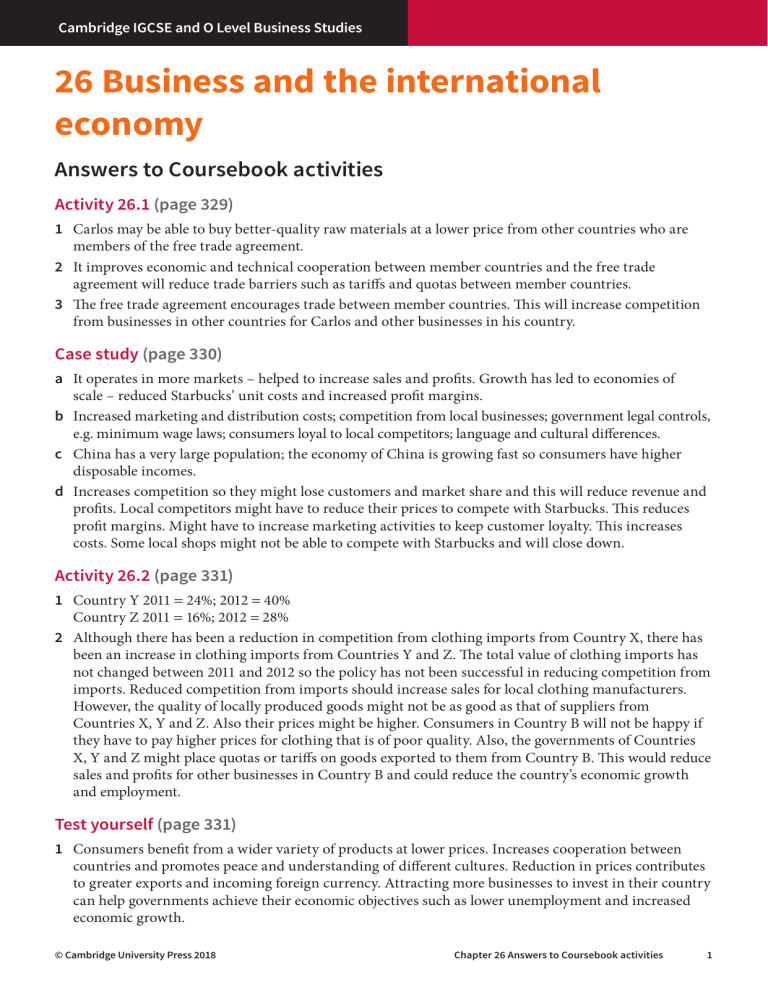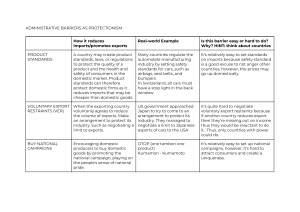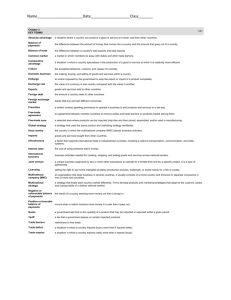
Cambridge IGCSE and O Level Business Studies 26 Business and the international economy Answers to Coursebook activities Activity 26.1 (page 329) 1 Carlos may be able to buy better-quality raw materials at a lower price from other countries who are members of the free trade agreement. 2 It improves economic and technical cooperation between member countries and the free trade agreement will reduce trade barriers such as tariffs and quotas between member countries. 3 The free trade agreement encourages trade between member countries. This will increase competition from businesses in other countries for Carlos and other businesses in his country. Case study (page 330) a It operates in more markets – helped to increase sales and profits. Growth has led to economies of scale – reduced Starbucks’ unit costs and increased profit margins. b Increased marketing and distribution costs; competition from local businesses; government legal controls, e.g. minimum wage laws; consumers loyal to local competitors; language and cultural differences. c China has a very large population; the economy of China is growing fast so consumers have higher disposable incomes. d Increases competition so they might lose customers and market share and this will reduce revenue and profits. Local competitors might have to reduce their prices to compete with Starbucks. This reduces profit margins. Might have to increase marketing activities to keep customer loyalty. This increases costs. Some local shops might not be able to compete with Starbucks and will close down. Activity 26.2 (page 331) 1 Country Y 2011 = 24%; 2012 = 40% Country Z 2011 = 16%; 2012 = 28% 2 Although there has been a reduction in competition from clothing imports from Country X, there has been an increase in clothing imports from Countries Y and Z. The total value of clothing imports has not changed between 2011 and 2012 so the policy has not been successful in reducing competition from imports. Reduced competition from imports should increase sales for local clothing manufacturers. However, the quality of locally produced goods might not be as good as that of suppliers from Countries X, Y and Z. Also their prices might be higher. Consumers in Country B will not be happy if they have to pay higher prices for clothing that is of poor quality. Also, the governments of Countries X, Y and Z might place quotas or tariffs on goods exported to them from Country B. This would reduce sales and profits for other businesses in Country B and could reduce the country’s economic growth and employment. Test yourself (page 331) 1 Consumers benefit from a wider variety of products at lower prices. Increases cooperation between countries and promotes peace and understanding of different cultures. Reduction in prices contributes to greater exports and incoming foreign currency. Attracting more businesses to invest in their country can help governments achieve their economic objectives such as lower unemployment and increased economic growth. © Cambridge University Press 2018 Chapter 26 Answers to Coursebook activities 1 Cambridge IGCSE and O Level Business Studies 2 Quotas limit the amount of goods that can be imported or exported. Tariffs are a tax on imports and exports that has the effect of increasing their prices. 3 Reduces trade barriers between member countries, which encourages trade and investment. Trade agreements often improve economic and technical cooperation between member countries. Activity 26.3 (page 332) 1 Are there any regulations or controls on foreign investments? Does the government provide any financial incentives such as tax incentives? How stable is the country’s currency? 2 Infrastructure affects operational efficiency. Businesses need reliable power supplies to make sure that production is not disrupted; good transport facilities for the delivery of raw materials and the distribution of finished goods to customers; effective communication systems so that the business can communicate easily and quickly with other businesses, suppliers and customers. 3 Social, political and operational factors such as skills and productivity of the labour force, political stability of the country, availability of raw materials and cost of land and buildings. 4 MNCs exploit countries’ natural resources, cause environmental damage; domestic businesses are unable to compete and may be forced to close down; could change local culture. Activity 26.4 (page 333) Stakeholder Shareholders Managers Customers Positive impact Potential to increase dividends and value of shares if the multinational increases overall profits. Negative impact There are likely to be high costs of becoming a multinational and if the venture fails it will reduce profits and reduce dividends and the market value of shares. Managers might be given the opportunity to Some of the work currently work in other countries. done in the home country Managers might have greater promotion might be transferred to opportunities. another country and could threaten job security. They will be able to receive goods more quickly Some production might be if produced in their own country/region. moved to other countries and Increases customer choice in the country/ this might affect quality and region where the multinational locates. availability. Suppliers Suppliers in the country where the multinational locates should sell more goods and increase their revenue and profits. Government Government where the multinational locates will benefit from increased tax revenue. Local community Increased job opportunities, which increases the standard of living. © Cambridge University Press 2018 Multinationals have stronger bargaining power and might force suppliers to reduce their prices, which will reduce their profit margins. The multinational might use all of the country’s natural resources and then leave. Risk of pollution caused by the multinational. Chapter 26 Answers to Coursebook activities 2 Cambridge IGCSE and O Level Business Studies Case study (page 335) a Availability of a large, hard-working and educated workforce. Close to markets where finished goods are sold, which reduces transport costs. b Reduces costs of production. Close to the North American market that GM sells to. Reduces unemployment. c GM will need to employ many employees in its new factory. Increases government tax revenue. Employees will pay tax on their wages and GM will pay tax on its profits. Improves Mexico’s balance of payments. GM will export the cars produced in Mexico to North America. GM cars no longer need to be imported into Mexico as they are now produced there. d There are potential drawbacks of MNCs locating in Mexico such as: possible environmental damage to the area where the factories are located; air, noise and traffic pollution; employees might be exploited by the MNCs, e.g. paid low wages; they might repatriate profits; the profits earned will not benefit the Mexican economy; they might exploit Mexico’s natural resources and, once these are exhausted, leave the country. Test yourself (page 335) 1 Easier access to raw materials, lower cost of labour, economies of scale, access to bigger markets, lower production costs, spread of risk, premium pricing for global brands. 2 Increases choice and quality of goods and services, improves country’s reputation, increases employment opportunities, generates income in the form of tax, improves infrastructure, knowledgesharing, improves balance of payments. 3 Undue influence on the government, increased competition, environmental damage, exploitation of labour and natural resources, repatriation of profits, negative social impact, less sense of social responsibility. Activity 26.5 (page 336) 1 GBP = 49 250; euro = 41 500 2 GBP Case study (page 338) a It has production and R&D bases in countries throughout the world. It has suppliers of raw materials in different countries and it sells its cars throughout the world. b Because it buys raw materials and components from different countries and its cars are sold in many different countries too. c South African factories can supply components and assemble cars at lower cost than in other countries. Also they are well placed geographically for exporting cars to other countries. If the ZAR appreciates against other currencies then local sales of cars produced in South Africa might fall because imported cars will become cheaper as a result of the appreciation of the ZAR. d Exports from South Africa will be more expensive so car sales to other countries are likely to fall. e A depreciation of the ZAR against other currencies will make exports cheaper so car sales from South Africa to other countries will probably rise. Test yourself (page 338) 1 The value of a currency falls against other currencies. 2 By increasing or decreasing import and export prices. 3 If a country’s currency appreciates then its exports will be more expensive and imports into the country will be cheaper. 4 If a country’s currency depreciates then its exports will be cheaper and imports into the country will be more expensive. © Cambridge University Press 2018 Chapter 26 Answers to Coursebook activities 3 Cambridge IGCSE and O Level Business Studies Exam-style practice questions (page 339) 1 a The process by which countries are connected to each other (1) through the trade of goods and services (1). [Total: 2] b A business organisation that has operations in more than one country (1), a business that sells in different countries (1). [Total: 2] c Increases the price of exports (1), will reduce sales of its products in foreign markets (1). Reduces the price of imports (1), will reduce Medico’s costs of production (1). [Total: 4] d Impose tariffs (1), increase the prices of imported goods (1), protects local businesses from cheaper competitor products from overseas (1). Set quotas (1), set a limit on the amount of a good that can be imported (1), consumers will still have to buy locally produced goods (1). [Total: 6] e Could bring both benefits and problems for the economy of Brazil (1); any relevant benefit, e.g. increases consumer choice and quality of products, increases employment opportunities, or drawback, e.g. increases competition, exploitation of labour (Maximum of 2). Explain one benefit, e.g. the MNC will employ local people and this may increase their skills or increase their income, which improves living standards, and one problem, e.g. the MNC will increase competition for local producers. The larger MNC will be able to charge lower prices because it enjoys economies of scale and this will reduce revenue and profits of local firms (Maximum of 2). The benefits outweigh the problem, or the problems outweigh the benefit (1 mark). [Total: 6] 2 a The foreign country (1) where a multinational sets up its operations (1). [Total: 2] b Can sell shares to the public (1). Owners have limited liability (1). [Total: 2] c Availability of resources (1) – is there a good and reliable supply of raw materials at a reasonable price (1)? Labour supply (1) – are there available employees with the right skills or who are capable of being trained (1)? [Total: 4] d Depreciation is a fall in the value of the currency (1), reduces the price of exports (1). Halim Leather will sell more goods in foreign markets (1), profits will rise (1), easier to enter new foreign markets (1), foreign governments might impose a tariff or quotas to reduce the increase in competition for local businesses of cheaper imports (1). [Total: 6] e Level of competition in foreign market (1), will consumers want to buy its products (1)? It must gain market share in the foreign market (1). Costs of entering the foreign market might be too costly (1), might be less risky to expand in its home market (1), if revenue from sales in the foreign market is greater than costs then profit will increase so it will be successful (1). [Total: 6] © Cambridge University Press 2018 Chapter 26 Answers to Coursebook activities 4



